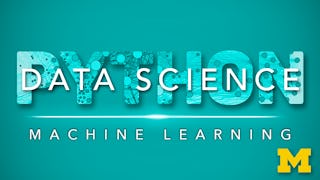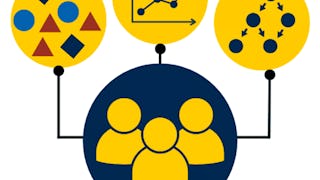In “Applied Unsupervised Learning in Python,” you will learn how to use algorithms to find interesting structure in datasets. You will practice applying, interpreting, and refining unsupervised machine learning models to solve a diverse set of problems on real-world datasets.


Applied Unsupervised Learning in Python
包含在 中
您将学到什么
Apply unsupervised learning methods, such as dimensionality reduction, manifold learning, and density estimation, to transform and visualize data.
Understand, evaluate, optimize, and correctly apply clustering algorithms using hierarchical, partitioning, and density-based methods.
Use topic modeling to find important themes in text data and use word embeddings to analyze patterns in text data.
Manage missing data using supervised and unsupervised imputation methods, and use semi-supervised learning to work with partially-labeled datasets.
您将获得的技能
要了解的详细信息

添加到您的领英档案
June 2025
21 项作业
了解顶级公司的员工如何掌握热门技能

积累特定领域的专业知识
- 向行业专家学习新概念
- 获得对主题或工具的基础理解
- 通过实践项目培养工作相关技能
- 获得可共享的职业证书

该课程共有4个模块
Welcome to Module 1! In this module, we will learn the basic unsupervised learning methods that focus on transformation of data: dimensionality reduction, manifold learning, and density estimation. We will be using realistic datasets for our analyses, implemented using the scikit-learn library. At the end of this Module, our assignment is to apply Principal Components Analysis to gain insight into a large real-world dataset. We will use manifold learning methods such as t-SNE to visualize complex structure, and use kernel density estimation to estimate probabilities of conditional events. Let’s begin!
涵盖的内容
18个视频7篇阅读材料7个作业1个编程作业1个讨论话题
Welcome to Module 2! In this module’s module, we will learn about clustering—another critical and widely-used unsupervised learning method. We will learn about the most important families of clustering algorithms, such as hierarchical methods (agglomerative bottom-up, divisive top-down), partitioning methods (k-means, k-medoids) and density-based methods (DBSCAN). We will also gain awareness of how to evaluate and optimize cluster quality. At the end of this module, our assignment is to apply a variety of these clustering approaches to realistic datasets using SciKit-Learn's clustering capabilities. Let’s begin!
涵盖的内容
10个视频3篇阅读材料5个作业1个编程作业
Welcome to Module 3! In this module’s module, we will learn about estimating latent variables—another important area of unsupervised learning, especially for text-based applications. We will focus first on the topic of text representations. Topic modeling is another form of latent variable estimation, which we will learn about via two different methods: Latent Dirichlet Allocation (LDA) and Non-Negative Matrix Factorization. We will also survey word embeddings to learn how to represent words with vectors in semantically useful ways. At the end of this module, our assignment is to solve problems through analyzing topic structure in a large document collection, and applying word embeddings to an NLP-related task. Let’s begin!
涵盖的内容
8个视频2篇阅读材料5个作业1个编程作业
Welcome to Module 4, our last module of the course! We wrap up our course by learning about how unsupervised methods can be integrated with supervised learning methods to improve prediction performance. A key topic this module in that direction covers imputation methods for dealing with missing data. We will also look at various special topics, including extensions of unsupervised learning that are used at the cutting edge of today's technology: semi-supervised learning and self-supervised learning. At the end of this module, our assignment is to apply methods and techniques for imputing missing data and semi-supervised learning, with the underlying theme being how unsupervised learning can improve supervised learning. Let’s begin!
涵盖的内容
7个视频3篇阅读材料4个作业1个编程作业
获得职业证书
将此证书添加到您的 LinkedIn 个人资料、简历或履历中。在社交媒体和绩效考核中分享。
位教师

从 Machine Learning 浏览更多内容
 状态:免费试用
状态:免费试用University of Michigan
 状态:免费试用
状态:免费试用 状态:免费试用
状态:免费试用University of Michigan
人们为什么选择 Coursera 来帮助自己实现职业发展




常见问题
To access the course materials, assignments and to earn a Certificate, you will need to purchase the Certificate experience when you enroll in a course. You can try a Free Trial instead, or apply for Financial Aid. The course may offer 'Full Course, No Certificate' instead. This option lets you see all course materials, submit required assessments, and get a final grade. This also means that you will not be able to purchase a Certificate experience.
When you enroll in the course, you get access to all of the courses in the Specialization, and you earn a certificate when you complete the work. Your electronic Certificate will be added to your Accomplishments page - from there, you can print your Certificate or add it to your LinkedIn profile.
Yes. In select learning programs, you can apply for financial aid or a scholarship if you can’t afford the enrollment fee. If fin aid or scholarship is available for your learning program selection, you’ll find a link to apply on the description page.
更多问题
提供助学金,




